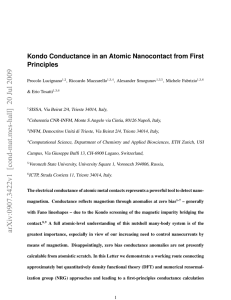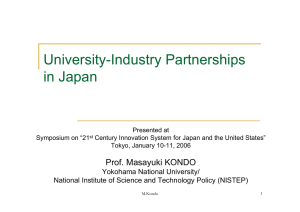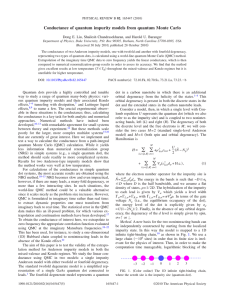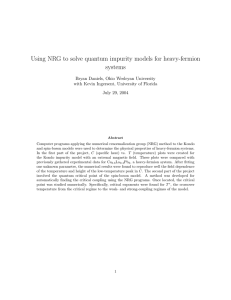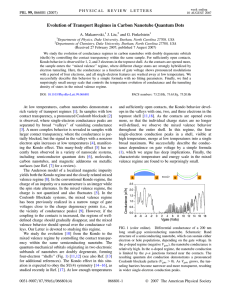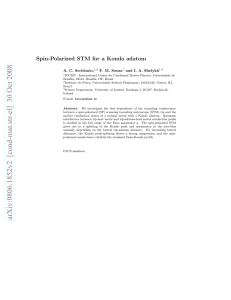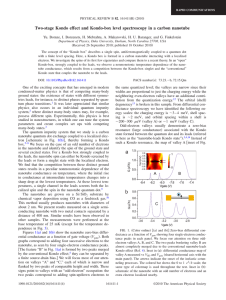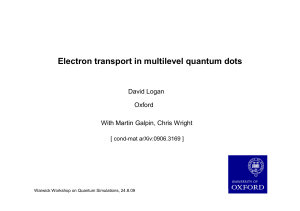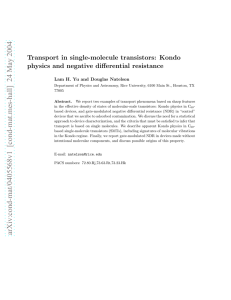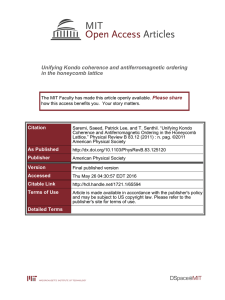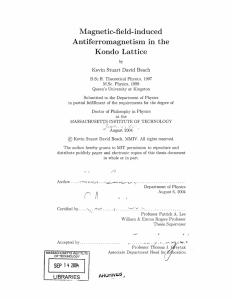t' asymmetry in the t-t'-J model
advertisement
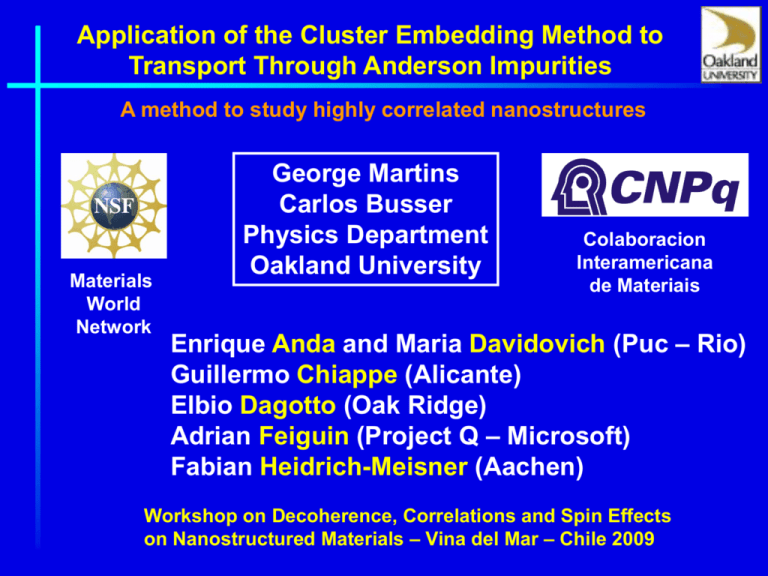
Application of the Cluster Embedding Method to Transport Through Anderson Impurities A method to study highly correlated nanostructures Materials World Network George Martins Carlos Busser Physics Department Oakland University Colaboracion Interamericana de Materiais Enrique Anda and Maria Davidovich (Puc – Rio) Guillermo Chiappe (Alicante) Elbio Dagotto (Oak Ridge) Adrian Feiguin (Project Q – Microsoft) Fabian Heidrich-Meisner (Aachen) Workshop on Decoherence, Correlations and Spin Effects on Nanostructured Materials – Vina del Mar – Chile 2009 Triangular geometry: interference and amplitude leakage t3 , t4 U t1 , t2 Treat the 3 dots as a molecule Enrique Anda (PUC – Rio) Carlos Busser (Oakland) Nancy Sandler and Sergio Ulloa (Ohio) Edson Vernek (Uberlandia) Bonding, non-bonding and antibonding orbitals t4 0 3 QDs in series 1 A 2 B C 2 2 A C 2 3 A 2 B C 2 A B C 12 3 t4 t3 equilateral 1 A 2 B C 2 A C 6 2 3 A B C 3 Just two leads (t2 = 0): t4 t3 Conductance: LDECA (blue) and Finite U Slave bosons (red) 4e 2e 3 6e U 1.0 t1 0.45 1 2 Vg Vg t3 0.5 interference The ‘partial’ conductances 3 2 L 2 e2 2 G3 Lt L 3 G3 R F h Gint G1 G2 2 G1G2 cos 12 G1r G2 r i12 ln G G 2 r 1r tL3 1 G3R Three leads (finite t and new parameter values) A C B A C U 1.0 t1 0.45 t3 0.5 A 2 B C A 2 B C Three leads (t2 = t1): t4 t3 G2 G3 G1 12 Amplitude ‘leakage’ ‘Orbital’ Degeneracy: Orbital Kondo Effect SU(4) Kondo Simultaneous screening of charge and spin Degenerate SU(4) Model and Hamiltonian U SU(4) U U H d n n Vg n U n n , ; 2 H int t d cl 0 h. c. l L , R ; ; t 0 t 0 t t t t t t t 0 t 0 Spin-charge ‘entanglement’ P. J. – Herrero et al., Nature 434, 484 (2005) Schematics of a co-tunneling process for the usual spin SU(2) Kondo screening. Same as above, but now for an orbital degree of freedom (orbital SU(2) Kondo). Simultaneous screening of orbital and spin degrees of freedom, leading to SU(4) Kondo. U=0.5 t'=0.2 t"=0.0 B=0.0 -1.6 U'=0.0 U'=0.2 U'=0.3 U'=0.4 U'=0.5 U'=0.0 U'=0.5 -1.2 -0.8 Vg -0.4 -0.04 0.0 -0.02 U 0.00 0.02 Galpin, Logan, and Krishnamurthy PRL 94, 186406 (2005) -2 SU(4) -0.04 0.04 2.25 2.20 2.15 0.0 CO 0.00 0.02 2.35 2.30 U U SU(4) 2.10 2.05 SU(2) -0.02 U 2.45 2.40 (10 ) U U U'=0.5 U'=0.6 U'=0.7 U'=0.8 LDOS() 2.0 1.8 1.6 1.4 1.2 1.0 0.8 0.6 0.4 0.2 0.0 LDOS G(2e2/h) and <n> SU(4) at Half-filling and NFL Behavior ECA Results 0.2 0.4 U' 0.6 0.8 0.04 Conductance Results 2.0 1.8 t'=0.2 1.6 G(2e2/h) 1.4 1.2 E U=U'=0.5 E=0.035 t'=0.1 1.0 0.8 0.6 0.4 0.2 n3 0.0 -2.0 -1.5 -1.0 -0.5 Vg n2 0.0 -1.5 -1.0 -0.5 Vg 0.0 0.5 U=U'=0.5 -2.0 t'=0.2 -1.5 t"=0.0 -0.5 Esp G(2e2/h) B 1.5 1.0 B Esp 1.6 2.0 1.2 1.0 0.8 0.5 0.6 2.5 1.0 0.0 1.5 0.0 1.0 -1.0 -2.5 0.5 Vg 1.0 0.0 Esp 0.5 =0.04 sp 0.5 =0.04 sp orb=0.2 orb=0.2 U=U'=0.5 -2.0 t'=0.2 -1.5 t"=0.0 0.0 t"=0.0 t"=0.05 t"=0.1 t"=0.15 t"=0.175 t"=0.2 1.4 Eorb -0.5 2.0 1.8 Eorb Vg -1.0 a 2.0 -2.5 SU(4) to 2LSU(2) 2.5 Esp a 3.0 Magnetic Field Dependence 3.0 0.4 0.2 U=U'=0.5 t'=0.2 B=0.0 0.0 -1.75 -1.50 -1.25 -1.00 -0.75 -0.50 -0.25 Vg 0.00 0.25 New results using LDECA (comparing with NRG) Density of states U 1.0 U ' 1.0 t 0.125 t 0.0 Results with field (12 sites) U 1.0 U ' 1.0 t 0.125 t 0.0 How does the Kondo peak behave? LDOS with field (half-filling) The peak seems to split at any finite field. Closer view Conclusions New numerical results for conductance in Carbon Nanotubes were presented ECA method seems capable of capturing glimpses of NFL behavior suggested by previous NRG results SU(4) regime at half-filling (HF) is confirmed: conductance results for third shell may then be reinterpreted as signature of SU(4) at HF Calculations at finite magnetic field agree quite well with experimental results Results indicating how conductance changes from SU(4) to 2LSU(2) regime were presented More detailed results with field seem to indicate that Kondo peak splits for any finite field. DMRG: the future of LDECA? Currently, the method is based on using Lanczos to solve for the Green’s functions of the cluster. • Advantage: Lanczos is fast and easy to program • Disadvantage: Maximum cluster size is still small. Finite size effects may occur. Solution? Use DMRG instead of Lanczos • Advantage: REALLY Larger clusters • Disadvantage: CPU time. Accuracy of Green’s functions? Size (only) doesn’t matter… EXACT No discretization (ECA) The importance of being discrete… LDECA Conclusions An improvement of embedding method was presented Results for single quantum dot agree perfectly with Bethe ansatz Results for density of states agree with NRG Two stage Kondo system (two hanging quantum dots) was discussed and compared with NRG Triangular configuration analyzed (interference) SU(4) in carbon nanotubes was analyzed Preliminary results using DMRG instead of Exact Diagonalization (very encouraging!) For the future: • Use two-particle Green’s function to calculate embedded spin correlations • Add temperature and bias (ambitious…)
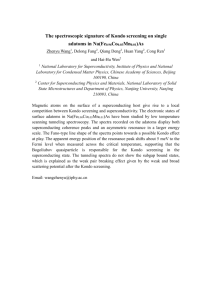
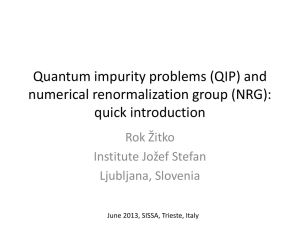
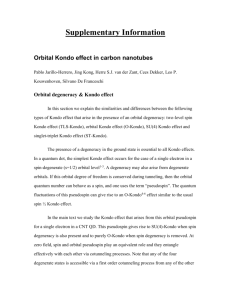


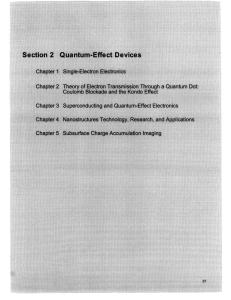

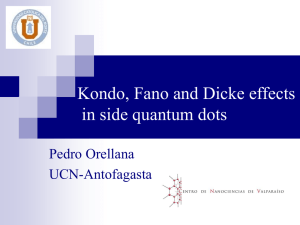

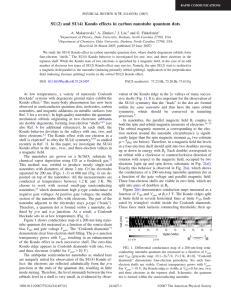
![arXiv:0704.2979v1 [cond-mat.str-el] 23 Apr 2007](http://s2.studylib.net/store/data/018687327_1-8f29eb7e9a70cca82b56188489135143-300x300.png)
